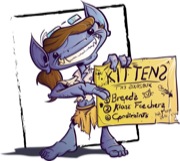I was looking at a few different threads discussing the various character roles and thought it would be a good idea to create a consolidated list. Here is what I have so far:
Character Roles
Battlefield Controller. Typically a wizard, this character uses their abilities to change the battlefield conditions so as to be favourable to their allies and/or unfavourable to their enemies. This is effectively an indirect form of buffing/de-buffing.
Blaster. Typically a sorcerer, this character specialises in inflicting large amounts of damage to multiple enemies, usually through area of effect spells like fireball. A Blaster that can inflict huge amounts of damage but is relatively weak defensively is sometimes referred to a glass cannon.
Buffer. Typically a bard, cleric or wizard, this is a character who focuses on directly improving the mechanical abilities of their allies.
Crafter. A character who builds or supplies equipment, which could be mundane, technological or magical to benefit their allies. This is typically the party wizard.
De-buffer. A character focused on reducing the mechanical effectiveness of their enemies directly rather than indirectly through battlefield control or tactical means. The witch is the classic de-buffer character class.
Face. This character is focused on the social interactions within the game. Any character class can be the face of the party but in practice it tends to be classes that favour high charisma scores like: bards, paladins, sorcerers and clerics.
Healer. A character focused on healing damage and condition removal, sometimes referred to as the healbot. This is typically a cleric or oracle and other classes like alchemists and paladins can make good secondary healers.
Leader. The party leader. This character is focused on getting the party to cooperate and pursue a common goal. This can be any character class although in practice most players will build a character that makes sense mechanically, for example they may have high charisma and/or the leadership feat. The Leader and Face are often the same character.
Melee Fighter. A character focused on engaging the enemy in melee combat. This is typically a monk, barbarian, paladin or fighter. Melee Fighters often fulfil the role of Tank.
Ranged Fighter. Typically a gunslinger, alchemist or archery focused ranger or fighter. This character specialises in dealing damage to the enemy from a distance.
Scholar. This is a character who focuses on being very knowledgeable and sharing that knowledge with the other characters to improve their decision making. Mechanically this is a character that focuses on knowledge skills such as a bard or wizard.
Scout. This is a character who specialises in finding potential threats and other things of interest without revealing their own location. Typically rogues and rangers make excellent Scouts.
Skill Master. Also unkindly referred to as the skill monkey. This is a character with a large number of skills at a relatively high level. Their role is to fill the skill gaps within the party. Typical classes include: bards, rogues and wizards although other classes like alchemists, rangers and inquisitors can adequately fulfil this role as well.
Summoner. This character summons, creates or otherwise procures NPCs to support the party. This is most commonly summoners or druids but can also be specialist wizards like conjurers or necromancers, or any character class with the leadership feat.
Survivalist. This character helps the party find food, water, shelter and cope with various natural hazards. Typically, rangers and druids.
Tank. A really tough character that is hard to damage and/or can take a lot of punishment. Ideally when in combat they are positioned so that they can prevent enemies from engaging more fragile party members like glass cannons (see Blaster). Tanks are typically barbarians, fighters or paladins and often fulfil the additional role of Melee Fighter. In some groups the Tank is replaced with summoned creatures that are uncharitably referred to as meat shields.
Transporter. This character improves the mobility of the party. At mid to high levels this is usually wizards, sorcerers and clerics.
Trap Master. This character is focused on finding and disarming traps and opening locks. Traditionally this is the province of the rogue, but other classes like investigators and rangers have archetypes that can perform this role as well.
Have I missed anything?




